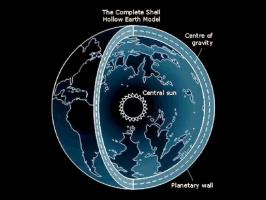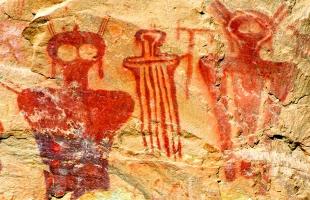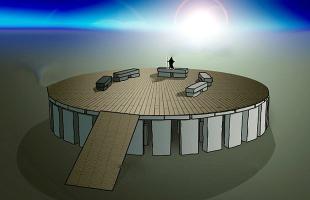Technology of the Ancients: Heaven on Earth?

Have you ever been in the situation where something is so obvious, it has been staring you in the face for a long time, and you've only just tumbled? Well I've experienced this with the djed hieroglyph. The clue lies in Egyptologists calling it "the backbone of Osiris". Robert Bauval in The Orion Mystery shows that the Giza site mirrored the stars of Orion's Belt in c.10450 BC. This is the 'backbone' of Osiris's constellation. According to Edgar Cayce, Osiris was instrumental in the building of the Great Pyramid. Does the djed seem familiar when you look at cross-sections of the Great Pyramid? It sure does to me. It is the 'spine' of the structure: the King's Chamber and the odd-looking 'weight-bearing' spaces above it. I've noted that it sometimes appears with the pyramid hieroglyph and ankh, as in this example:This configuration may suggest that the pyramids were tombs and that the shafts in the King's and Queen's Chambers of the Great Pyramid were for 'projecting' the pharaoh's soul to the Heavens as Bauval suggested. However, I believe there are too many odd feaures in the pyramid for it to be a mere burial place and route to the Afterlife. For example, have you ever wondered why the King's Chamber is granite, when the rest of the pyramid is limestone? And what is the significance of the strange niche in the Queen's chamber? One of the most baffling things for me is why the pyramid has heavier stones nearer the top and lighter ones nearer the bottom!
If you haven't got one already, try to get hold of a copy of Alan Alford's Gods of the New Millennium [Hodder and Stoughton, London, 1996], and read pages 192-219 [the diagrams on 197, 199, 206, 208, 210, but particularly 215, illustrate his fascinating and controversial theories on the pyramid's function.]
The di hieroglyph made me think of a diagram by Zecharia Sitchin Alford included on pg.181 in Chapter 8, Proofs of Divine Guidance. This depicts the "flight path of the gods", connecting the twin-peaked Mt Ararat [think Noah and Cayce's King Araaraat], Turkey, the Sphinx and Heliopolis, Egypt [the latter a very sacred site, and an early pharonic coronation place], Baalbek, Lebanon [the Temple of Jupiter has three megalithic stones under it, each of several hundred tons], Jerusalem, and the triple-peaked Mt Umm Shumar. Sitchin's image comes from his book Gateway to Heaven. Alford says these sites were beacons [Heliopolis and Mt Sinai [think Moses and the Commandments] and flight centres, the "mission control centre" being Jerusalem. The symbol [above right] comes from a piece of pectoral jewellery once worn by Tutankhamun.
Another traditional "flight path of the gods" [if you believe von Daniken] is the Nazca Plain in Peru. When the Conquistadors arrived in the 16th century they took this feature [right] to symbolise the Holy Trinity.
I've been puzzling over this one, and that some believe the ancient Nazcans pictured constellations on the plain. Graham Hancock in Heaven's Mirror [London, 1998] suggests that the "gigantic spider" is Orion, and that this figure is closer to the star formation than the Egyptians humanoid with ankh. He also speculates that the trident depicts the Southern Cross [Crux Australis], a constellation "known to the astronomer-priests of the Andes" [pg. 258]. Alford calls it, "a well-known symbol of an ancient god".
I came up with this: Alford mentions the pre-Inca deity Viracocha and says local mythology considers the trident "the lightning rod" of this god. Well, Zeus had his thunderbolt and Thor his hammer, and isn't life is supposed to have been 'sparked' into existence In the Beginning? I'd be very interested to know what you think on all of this....





















